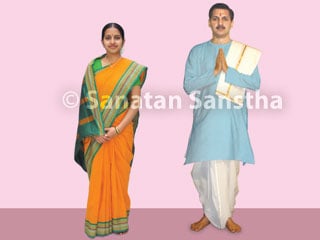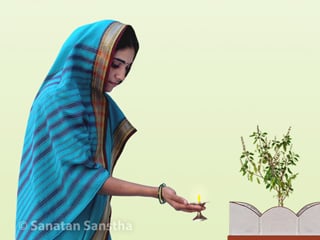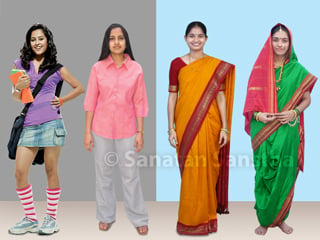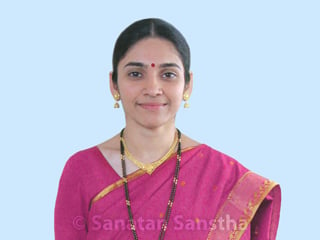Every object has indigenous vibrations with its own attributes. The vibrations of clothes depend on factors such as the type of cloth, shape, colour, design, stitching of the cloth etc. The more sattvik (Sattva-predominant) these components are, the greater is the Sattva component of the final product, that is, the clothes. An average individual should wear sattvik clothes so that he can imbibe Chaitanya (Divine consciousness) from them. This article explains why do we wear clothes ? It also explain the importance of wearing sattvik clothes and its advantages from physical, psychological and spiritual perspective.
1. Why do we wear clothes ? – The physical perspective
Besides protecting the modesty, clothes protect the body from the cold, wind, sunshine and rain.
2. Why do we wear clothes ? – The psychological perspective
Clothes help recognize an individual’s temperament and personality
An individual selects clothes according to his temperament. People who always wear neat and ironed clothes are disciplined and conscientious. Those who wear casual clothes are frank and whimsical. Those who always wear untidy and weird clothes are lazy and careless. In short, clothes help identify the temperament and personality of an individual. Hence, it becomes necessary that an individual wear clothes complementary to a situation. For example, going for a job interview in neat and ironed clothes demonstrates the qualities of discipline and gentility.
3. Why do we wear clothes ? – The spiritual perspective and its importance
A. Wearing clothes amounts to taking the support of
Maya (The Great Illusion) to attain a level of Brahman-realized state
If being without clothes denotes renouncing attachment in the form of Maya and attaining a level of Brahman-realized state, then wearing clothes amounts to taking the support of Maya to be attractive and be able to attain a level of Brahman-realized state.
B. Wearing clothes prescribed by Hindu Dharma
results in the activation of the Shiv and Shakti Principles through them
Clothes worn by men and women as prescribed in Hindu Dharma are designed by Deities and are those that manifest the Shiv (God Principle) and Shakti (Divine Energy) Principles. The clothes of women, meaning the sari, awaken the Shakti Principle and the clothes of men activate the Shiv Principle. Wearing clothes as prescribed by the scriptures gives us the experience of our true identity. It also conserves our spiritual energy. Wearing clothes designed by the Deities automatically provides the energy necessary for the gross and the mental body.
C. Wearing clothes as prescribed by Hindu Dharma attracts Chaitanya and Principles of Deities
Two examples are given ahead.
-
Kurta and pyjama : Wearing a kurta and pyjama generates an elliptical (similar to the flame of a lamp) protective sheath around the body. This makes it easier for the individual to imbibe Chaitanya from the atmosphere and combat Raja-Tama components.
-
Sovale : Sovale is more sattvik than kurta and pyjama. Wearing it generates a subtle spherical protective sheath around the body of the individual and simplifies imbibing of both, the marak-tarak (Destroyer-Saviour) and the sagun-nirgun (Materialised and Non-materialised) Principles of the Deities.
D. Attraction and emission of sattvikta (Purity) to and from
the clothes depends on the type of clothes and the way they are worn
| Clothing and style of wearing them | The capacity to imbibe and emit sattvikta |
|---|---|
| 1. Nine-yard sari and dhoti | Maximum |
| 2. 1. Six-yard sari :
A. Pallu over the left shoulder |
More |
| Lungi | Less |
| 1. Churidar pyjama
A. Dupatta over both the shoulders B. Dupatta over one shoulder |
Less than six-yard sari
More Less |
From the above-mentioned facts, we can understand the importance of traditional Hindu clothes such as the nine-yard sari and dhoti. This is one supreme example that shows how Hindu culture is full of Chaitanya.
E. Wearing sattvik clothes as advised by Hindu Dharma
during festivals and rituals helps imbibe maximum Chaitanya
In Hindu Dharma, several Holy festivals, Religious festivals and Vowed religious observances are celebrated throughout the year. Besides, there are religious rituals that include ritualistic worship, thread ceremonies, marriages, etc. On days such as Ramnavami, Janamashtami, Hanuman Jayanti, and Prakatdin of Saints, the Principle of the respective Deities and Saints is predominantly active. During religious rituals, we invoke the Deities at the site of the ritual, and hence, they are present there. In short, the respective Chaitanya is active in a greater proportion on those days. Wearing sattvik clothes as advised by Hindu Dharma on these days allows us to benefit from that Chaitanya. For example, it is appropriate for women to wear a six-yard or a nine-yard sari with a border made of gold or silver thread work, and for men to wear a dhoti or kurta-pyjama.
F. Protection from the attack of negative energies because of clothes
Do not remain impure and naked; else you may suffer from negative energy distress.
शाqक्तविषये न मुहूर्तमप्यप्रयतः स्यात् । नग्नो वा – Apastambadharmasutra, 1.5.15.8-9
Meaning : If possible, do not remain impure or naked even for a moment.
To prevent distress due to negative energies, babies are kept wrapped in a cloth and not left naked.
G. Wearing clothes as advised by Hindu Dharma provides protection from negative energies
Flow of energy from the folds of a sari is towards the ground and it protects women from negative energies emanating from Patal (Hell region) : Energy Principle emitted from the sari wages a battle with the negative energies present in the environment. It reduces the influence of negative energies on the mind and the body of the individual. A white blaze of light emitted from each fold of the sari appears like a sword. As the flow of energy from the folds of a sari is directed towards the ground, women are protected from the negative energies emanating from Patal.
H. Wearing new or silk clothes and different ornaments on festivals or
religious rituals and auspicious days provides protection from negative energies
During festivals, yadnyas, religious ceremonies such as the thread ceremony, weddings, vastushanti ceremony etc., a subtle-battle between the Deities and the negative energies takes place in the Universe, the atmosphere, and the premises, in that order. Therefore, people celebrating the festival and the ones who are present at the venue of the ceremonies can be affected by the subtle-battle and suffer from distress due to negative energies. By wearing gold ornaments and new or silk clothes, the sattvikta of the wearer increases with the formation of a protective sheath of sagun-nirgun level Chaitanya of God and the individual is protected from the attack of negative energies.
Reference : Sanatan Sanstha’s Holy text ‘How should the clothes be from a spiritual perspective ?’


 Sewing Clothes and Effect of Stitching
Sewing Clothes and Effect of Stitching Practical suggestions on Wearing Clothes
Practical suggestions on Wearing Clothes Significance of taking saree pallu (free end of the saree) over head
Significance of taking saree pallu (free end of the saree) over head Subtle effect and Importance of dress worn by a woman
Subtle effect and Importance of dress worn by a woman Subtle effects of different neckline patterns of a garment worn by women
Subtle effects of different neckline patterns of a garment worn by women Significance of wearing Sahavari saree (Six-yard saree)
Significance of wearing Sahavari saree (Six-yard saree)